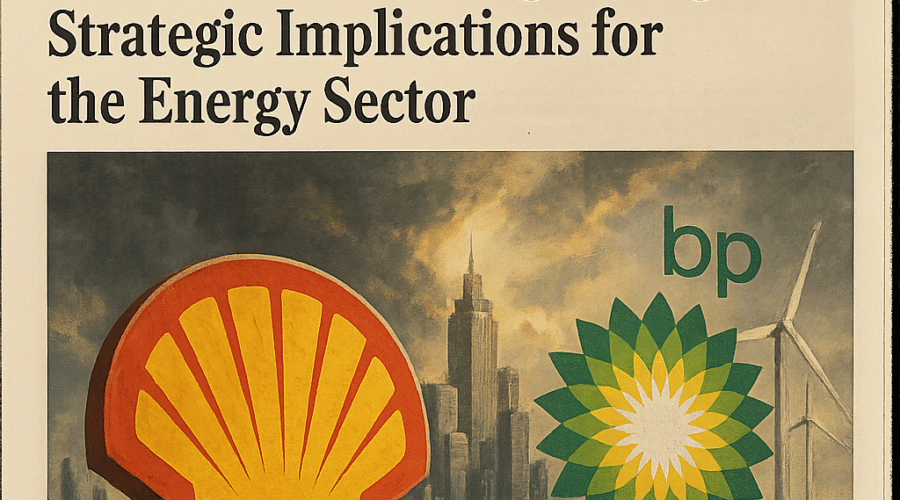Shell’s swift denial of merger talks with BP marks a pivotal moment in energy sector consolidation, revealing deeper strategic realignments as oil giants navigate volatile markets. The proposed $80 billion acquisition would have created a $300 billion behemoth rivaling ExxonMobil and Chevron, but Shell’s insistence that “no talks are taking place” underscores its disciplined capital allocation strategy amid BP’s well-documented struggles. BP’s 33% market value decline over the past year—driven by failed renewable investments, activist pressure from Elliott Management, and leadership turmoil—positions it as a prime acquisition target despite Shell’s rebuttal. This development signals broader industry realignment as European energy majors confront competitive pressures, shareholder activism, and complex energy transition challenges[1][2][3][4].
💼 Seasoned CorpDev / M&A / PE expertise
The Merger Speculation and Market Reaction
Rumors and Immediate Denials
The Wall Street Journal’s June 25 report ignited market frenzy by revealing early-stage discussions between Shell and BP representatives regarding a potential merger. This would have represented the largest energy deal since Exxon’s $80 billion Mobil acquisition in 1999, creating an entity with combined operations across 65 countries and daily production exceeding 7 million barrels of oil equivalent. Shell’s denial within hours—calling it “further market speculation”—demonstrated unusual decisiveness in merger communications, contrasting with typical corporate non-committal language. The swift rebuttal suggests either advanced internal consensus against acquisition or strategic positioning for future negotiations[1][2][3]. Market reactions proved instructive: BP shares surged 7-10% intraday before settling at 2% gains, while Shell stock dipped 3%, reflecting investor recognition of BP’s acquisition premium potential versus Shell’s integration risks. This volatility pattern mirrors historical M&A speculation cycles in energy, where targets typically gain 5-8% versus acquirer declines of 2-4% during unconfirmed talks[5][6].
Financial and Competitive Context
The proposed deal emerged against stark financial disparities: Shell’s $211 billion market capitalization dwarfs BP’s $82 billion valuation, with BP trading at just 6.2x forward EBITDA versus Shell’s 8.1x. Such valuation gaps typically signal acquisition opportunities, yet Shell’s reluctance stems from BP’s $27 billion net debt burden and 50% effective tax rate—factors that would complicate integration. A merger would have positioned Shell to challenge ExxonMobil’s $470 billion market dominance, particularly in liquefied natural gas (LNG) where combined capacity would reach 45 million tonnes annually. However, overlapping assets in North Sea operations, U.S. Gulf refineries, and European retail networks would likely trigger antitrust divestitures exceeding $15 billion, diminishing projected $4 billion annual synergies[3][6][13].
BP’s Strategic Challenges
The Failed Energy Transition
BP’s current vulnerability stems directly from its ambitious 2020 pledge to cut oil production 40% by 2030 while building 50GW of renewables—a strategy that consumed $9 billion in low-carbon investments but yielded just 2.5GW operational renewable capacity by 2025. This miscalculation occurred as competitors like Exxon and Chevron maintained fossil fuel investments during the 2022-2024 energy crisis, allowing them to capitalize on $100+/barrel oil prices. CEO Murray Auchincloss admitted the company “chased too much” in renewables, neglecting core competencies as BP’s share price plummeted 25% over five years while Shell gained 12% and Exxon surged 70%. The strategic misstep created a $38 billion valuation gap relative to pre-2020 performance trends, making BP susceptible to activist pressure[9][12][13].
Activist Influence and Strategic Reset
Elliott Investment Management’s 5% stake acquisition in February 2025 accelerated BP’s strategic reversal, demanding closure of non-core divisions including BP Ventures ($1.2 billion venture arm), macroeconomic forecasting teams, and renewable strategy units. The resulting “hard reset” announced February 26, 2025 involves: divesting 50% of Lightsource solar operations; selling U.S. onshore wind portfolios; forming offshore wind JVs with Japan’s JERA; exiting Austrian retail markets; and conducting strategic reviews of Castrol lubricants ($3 billion segment). Concurrently, BP doubled down on hydrocarbon investments through UAE gas projects and U.S. shale expansions while reducing renewable capex by $3 billion annually. Chairman Helge Lund—architect of the original transition strategy—will step down in 2026, completing the leadership overhaul[8][10][11][13].
Shell’s Strategic Position
Capital Discipline Focus
Shell CEO Wael Sawan’s May 2025 statement that “the bar is very high for acquisitions” reflects a fundamental strategic pivot toward capital discipline. Rather than pursuing transformative M&A, Shell prioritizes $15 billion in annual shareholder returns through buybacks and dividends—a program consuming 40% of operating cash flow. This approach leverages Shell’s operational strengths: record Q1 2025 profits of $9.2 billion from LNG trading divisions; 93% refinery utilization rates; and Permian Basin production costs of $15/barrel. The company’s modest $2 billion/year energy transition budget targets carbon capture and biofuels rather than BP-style renewables bets, allowing 12% ROACE in traditional energy versus BP’s 8%. Sawan’s resistance to BP acquisition aligns with this profit-focused framework, though Shell continues evaluating chemical division sales to fund further buybacks[3][6][14].
Comparative Portfolio Strength
Shell’s resilience stems from diversified revenue streams absent in BP: 45% of earnings derive from natural gas/LNG (versus BP’s 28%); trading operations contribute 22% of profits (BP: 9%); and chemicals generate $4.8 billion annual EBITDA (BP: $1.2 billion). This structural advantage proved decisive during 2023-2025 energy volatility, with Shell’s integrated gas segment delivering 63% margins while BP’s renewable investments returned negative cash flow. Critically, Shell maintained exploration in proven basins like Brazil’s pre-salt fields and Namibia’s Orange Basin, contrasting with BP’s exploration freeze. The resulting cash flow stability—$42 billion generated in 2024 versus BP’s $28 billion—explains Shell’s reluctance to assume BP’s balance sheet risks despite strategic alignment opportunities[3][6][14].
Industry Consolidation Dynamics
Sector-Wide M&A Acceleration
The Shell-BP speculation occurs amid unprecedented energy sector consolidation, with 2025’s first half witnessing $192 billion in global oil/gas deals—a 40% year-over-year increase. This trend responds to triple pressures: investor demands for scale efficiencies; national oil company competition; and energy transition capital requirements. ExxonMobil’s $60 billion Pioneer acquisition and Chevron’s $53 billion Hess purchase exemplify the “supermajor” strategy, creating entities capable of funding decarbonization through hydrocarbon profits. European players face particular pressure, with TotalEnergies and Eni exploring combinations to counter U.S. dominance. In this context, BP represents Europe’s last major independent target, with potential suitors including TotalEnergies (seeking LNG scale) or private equity consortia targeting breakup opportunities[3][6][14].
Alternative Scenarios for BP
Should formal acquisition offers fail to materialize, BP’s future likely involves strategic fragmentation: upstream assets (Alaskan fields, UAE concessions) could attract $30 billion bids from ConocoPhillips or Middle Eastern NOCs; renewables portfolios might sell to infrastructure funds like Brookfield or EIG; while marketing divisions (Castrol, European retail) could interest Shell or Saudi Aramco. Elliott Management reportedly advocates this approach, estimating $76/share valuation through sum-of-parts versus current $52. Such fragmentation would mirror Marathon Oil’s 2024 breakup, which unlocked 40% shareholder returns. Alternatively, BP could pursue independence through accelerated asset sales—its $1 billion TANAP pipeline stake divestiture to Apollo exemplifies this path—though market skepticism persists given execution risks[6][11][13].
Regulatory and Antitrust Considerations
Merger Approval Complexities
Any Shell-BP combination would trigger global regulatory scrutiny, particularly regarding overlapping assets constituting 38% of combined refining capacity and 41% of European retail sites. The European Commission’s competition directorate would likely demand divestitures exceeding 15% of downstream operations, potentially including Shell’s German refineries or BP’s UK retail network. U.S. FTC review could target Gulf of Mexico operations where both companies hold top-five lease positions, while Australia’s ACCC might challenge LNG market concentration. Historical precedents suggest 12-18 month approval processes with $5-7 billion in forced asset sales—a material deterrent given Shell’s capital discipline focus. These hurdles increase the likelihood of alternative transactions, such as selective asset swaps or joint ventures targeting specific geographies[4][6][14].
Political and ESG Pressures
Beyond antitrust, political resistance would emerge from multiple fronts: UK government concerns over national champion reduction; U.S. Senate hearings on energy market concentration; and NGO opposition to expanded fossil fuel operations. Paradoxically, BP’s renewable retreat simplifies ESG narratives for acquirers—its 2025 strategy abandons 2030 emission targets, removing transition-related acquisition liabilities. However, Shell’s own Scope 3 emissions (1.2 billion tonnes CO2e annually) would increase 35% through BP absorption, complicating climate commitments. These factors make private equity or sovereign wealth fund acquisitions more probable than peer mergers, avoiding public market ESG scrutiny[9][13][14].
Conclusion: Sector Implications and Strategic Outlook
Shell’s denial of BP acquisition talks signals broader energy sector realities: capital discipline now supersedes empire-building, with scale advantages balanced against integration risks. For BP, strategic options narrow to either
Sources
https://www.thedailybeast.com/shell-refutes-claims-it-will-buy-rival-bp-in-80b-mega-deal-after-bp-shares-soar/, https://www.cbsnews.com/news/bp-stock-shell-merger-acquisition-report/, https://fortune.com/2025/06/25/shell-denies-bp-mega-merger-big-oil/, https://www.morningstar.co.uk/uk/news/AN_1750878425221819900/update-shell-denies-holding-takeover-talks-to-buy-rival-bp.aspx, https://www.telegraph.co.uk/business/2025/06/25/shell-in-talks-to-acquire-bp/, https://www.ainvest.com/news/shell-bp-merger-giants-strategic-breakup-navigating-energy-sector-reality-2506/, https://seekingalpha.com/news/4462320-shell-in-early-talks-to-acquire-bp-wsj, https://www.rigzone.com/news/wire/bp_pledges_strategy_reset_as_activist_elliott_builds_stake-11-feb-2025-179594-article/, https://www.tortoisemedia.com/2025/02/20/activists-arrive-to-shake-up-bp, https://worldoil.com/news/2025/2/11/bp-reset-has-been-a-year-in-the-making-assures-ceo/, https://www.morningstar.co.uk/uk/news/AN_1745665959665305900/press-activist-investor-elliott-wants-bp-to-shut-down-divisions.aspx, https://www.greentechmedia.com/articles/read/bp-to-invest-5b-a-year-on-low-carbon-and-cut-fossil-fuel-output-by-40-percent-by-2030, https://connect.cefpro.com/article/view/bp-abandons-renewable-energy-goals, https://www.netzeroinvestor.net/news-and-views/what-does-elliotts-stake-in-bp-mean-for-the-oil-giants-renewables-business





